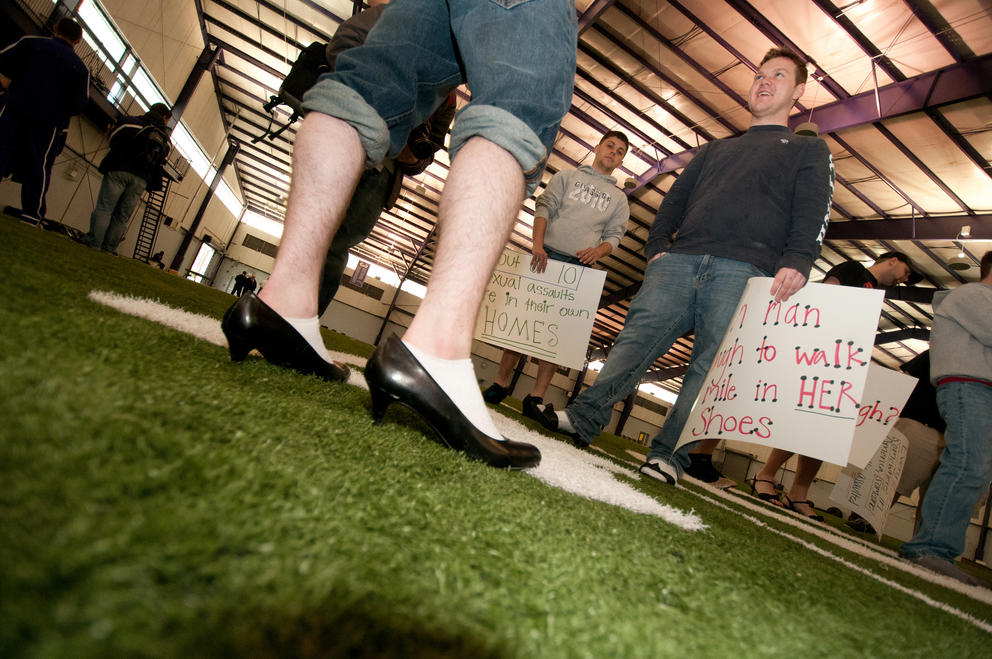.sidebar{
padding:12px;
border-top:4px solid #274565;
background-color:#eeede4;
margin-top:12px;
margin-bottom:12px;
}
.sidebar p.source{
font-size:14px;
color:#666;
margin-top:12px;
}
.sidebar td{
border-bottom:1px solid #ccc;
padding:4px 0;
}
.right{
float:right;
margin-left:12px;
width:50%
}
.left{
float:left;
margin-right:12px;
width:50%;
}
.footnotes{
border-top:1px solid #666;
}
.footnotes p{
font-size:14px;
color:#666;
}
.footnotes h2{
font-size:24px;
}
Though politicians and universities across the country have recognized the problem of campus sexual assault, administrators are still working to determine the most effective policies and programs for reducing students’ vulnerability.
At Washington State University, for example, mandatory workshops teach incoming students how to identify violent behavior and intervene when their peers are at risk. At Western Washington University, posters listing survivor resources are in every restroom on campus.
But establishing more universal policies is a work in progress that state administrators, Title IX coordinators, student groups and other entities are tackling in a collaborative effort. A report published by the Washington State Council of Presidents last month outlines some suggested policies and tactics, such as improving prevention trainings, addressing the needs of underserved populations, and streamlining the reporting and disciplinary processes.
The efforts have received a push from state lawmakers. In May 2015, the Washington Legislature passed a bill establishing the Campus Sexual Violence Prevention Task Force, which evaluated the resources available at the state’s six universities and 34 community and technical colleges.
“We know that we have a problem on our campuses,” said Sen. Barbara Bailey, R-Oak Harbor, who sponsored the bill in the Senate. “We want to make sure that all of our students are safe. That is my No. 1 priority.”
91%
of Western Washington University respondents feel safe on campus. At Central Washington University, 75% of respondents reported feeling safe.
Source for all graphics: Campus Sexual Violence Prevention Task Force Final Report to the Legislature, Appendix G
Several of the universities offer prevention education programs such as Green Dot workshops, which have become popular at universities across the country. The workshops teach students how to recognize and respond to risky or potentially violent situations. While the trainings are optional at the University of Washington and Evergreen State College, they have been mandatory for all incoming undergraduate and transfer students at Washington State University since 2014.
Nikki Finnestead, WSU’s violence prevention coordinator, said the Green Dot program was “an ideal fit” for WSU, and that many students report they have used the skills taught at the workshops in real-life situations. However, she noted the importance of offering prevention training multiple times during a student’s career.
Training at Washington State University
Almost half of all students at Washington State University reported they have received training in multiple topics associated with sexual harassment and assault.
Legal definition of sexual assault
51%
Definition of consent and how to obtain it
51%
WSU’s policy on sexual assault
52%
How to report sexual assault
51%
Services available for survivors or sexual assault
48%
How to intervene as a bystander to protect other students from sexual assault
41%
Other strategies for preventing sexual assault
43%
“What we know about effective prevention education is that a one-time workshop, regardless of its content or program facilitators, will have limited impact in creating long-term change,” Finnestead said. “That’s why it is crucial that our efforts are ongoing.”
Though mandatory Green Dot workshops have been a successful tool for WSU, Finnestead said that each college campus must consider its unique population and resources when establishing mandatory programs. Sen. Bailey agreed.
“The environment in each one of our schools is a little different,” Bailey said. “We want to make sure that the school has the authority or the option of being able to adopt rules in their school that work with their student body.”
The task force also called for further research on prevention and response efforts for students with disabilities, students under 18, LGBTQ students, and other underserved populations.
Katie Querna, who researches gender and sexuality norms in the UW School of Social Work, said the needs of these groups are often not addressed in school policies because of limited definitions of sexual assault.
“We have to recognize that all of our policies are set up in a very heteronormative way,” Querna said. “It assumes that certain people can be victims and certain people cannot be victims. Certain people have the ability to give consent and certain people don’t have the ability to give consent.”
The task force also suggested improvements to the reporting process, such as reducing the amount of time it takes to address a student conduct charge and improving training for law enforcement officers. Bailey said protecting the rights of all people involved in the disciplinary process is a top concern. “We want to make sure that due process is always part of the equation,” Bailey said.
Knowledge of their institution's policy on Sexual Assault
Students' knowledge of their institution's policy on sexual assault, such as where to report an assault or how the institution deals with the report, varied greatly between schools.
Community and technical colleges
Less than 50%
Evergreen State College
30%
Central Washington
40%
Washington State University
60%
Western Washington University
65%
The report includes recommendations specifically mentioned by surveyed students, such as self-defense classes, more education on recognizing and reporting sexual assault, and better lighting and security resources on campus. Though many schools share information about various safety resources during freshman orientation, many students feel that’s not enough.
At some universities, students and student governments have created programs to improve education on sexual assault. At UW, for example, the Associated Students of the University of Washington (ASUW) Sexual Assault and Relationship Violence Activists held a series of events as part of Consent Week from Jan. 9 to Jan. 13. Activities included peer discussions, guest speakers and a film screening.
Alexander Wirth, director of ASUW’s Office of Government Relations, said the group is currently working on follow-up legislation based on the task force’s recommendations. He said the student governing body can provide a different perspective from what might come to mind for school administration or lawmakers because of their familiarity with student life.
Paul Francis, executive director of the Council of Presidents, said policy makers have expressed an interest in pursuing legislation based on the task force’s findings. He said the task force has given Washington the opportunity to “be a national leader on this issue.”
“Even though the task force is over, the work is definitely going to continue,” Francis said. “There is a very strong commitment to continuing to do what we can to keep our students safe.”
Wording for some survey questions varied among different campuses. Details for all the questions and other survey findings at the universities and community colleges can be found in Appendix G of the Campus Sexual Violence Prevention Task Force Final Report to the Legislature.



